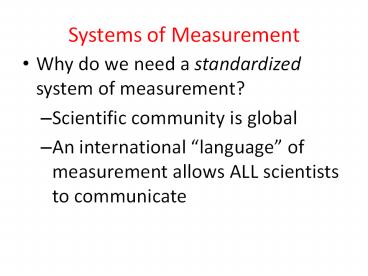Systems of Measurement PowerPoint PPT Presentation
1 / 17
Title: Systems of Measurement
1
Systems of Measurement
- Why do we need a standardized system of
measurement? - Scientific community is global
- An international language of measurement allows
ALL scientists to communicate
2
Metric System SI
- The first standardized system of measurement the
Metric system - Developed in France in 1791
- Named based on French word for measure
- based on the decimal (powers of 10)
- Systeme International d'Unites(International
System of Units) - Modernized version of the Metric System
- Abbreviated by the letters SI.
- Established in 1960, at the 11th General
Conference on Weights and Measures. - Units, definitions, and symbols were revised and
simplified.
3
Components of the SI System
- The SI system of measurement has 3 parts
- base units
- derived units
- prefixes
4
SI Base Units
Physical Quantity Unit Name Symbol
length meter m
mass kilogram kg
time second s
electric current ampere A
temperature Kelvin K
amount of substance mole mol
luminous intensity candela cd
5
SI Derived Units
Physical Quantity Unit Name Symbol
area square meter m2
volume cubic meter m3
speed meter per second m/s
acceleration meter per second squared m/s2
weight, force newton N
pressure pascal Pa
energy, work joule J
6
Prefixes
Prefix Symbol Numerical Multiplier Exponential Multiplier
yotta Y 1,000,000,000,000,000,000,000,000 1024
zetta Z 1,000,000,000,000,000,000,000 1021
exa E 1,000,000,000,000,000,000 1018
peta P 1,000,000,000,000,000 1015
tera T 1,000,000,000,000 1012
giga G 1,000,000,000 109
mega M 1,000,000 106
kilo k 1,000 103
hecto h 100 102
deca da 10 101
no prefix means no prefix means 1 100
7
Prefixes
Prefix Symbol Numerical Multiplier Exponential Multiplier
no prefix means no prefix means 1 100
deci d 0.1 101
centi c 0.01 102
milli m 0.001 103
micro m 0.000001 106
nano n 0.000000001 109
pico p 0.000000000001 1012
femto f 0.000000000000001 1015
atto a 0.000000000000000001 1018
zepto z 0.000000000000000000001 1021
yocto y 0.000000000000000000000001 1024
8
Staircase Method
9
Problem convert 114.55 cm to km
10
Dimensional AnalysisFactor-Label Method
- Multiply by conversion factor (a fraction that
relates the original unit and the desired unit) - Conversion factor is always equal to 1.
- Numerator and denominator should be equivalent
measurements. - When measurement is multiplied by conversion
factor, original units should cancel
11
Dimensional AnalysisFactor-Label Method
- Convert 6.5 km to m
12
- Convert 3.5 hours to seconds
13
Units of Volume
- The space occupied by matter
- Derived from length (m3)
- Non-SI Liter
- 1000 cm3 1 L 1 mL 1 cm3
- Instruments graduated cylinder, pipet, buret,
volumetric flask
14
Units of Temperature
- Temperature a measure of how hot or cold an
object is (the avg. kinetic energy of particles
in matter) - Heat flows from higher temp. to lower temp.
- Substances expand as temp. increases
(exception??)
15
- Celsius scale
- -freezing point of water
- -boiling point of water
- Kelvin scale
- -freezing point of water
- -boiling point of water
- 0 K (absolute zero) -273.15C
- K C 273 C K - 273
16
(No Transcript)
17
Units of Energy
- Joule (J) SI unit of energy
- Calorie (cal)
- 1 J 0.2390 cal
- 1 cal 4.184 J

